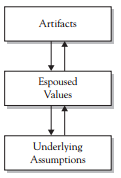Schein's model of organizational culture
| Line 15: | Line 15: | ||
These levels range from the very tangible open manifestations that one can see and feel to the deeply embedded, unconscious, basic assumptions defined as te essence of culture. In between these layers are various espoused beliefs, values, norms and rules of behavious that members of the culture use as a way of depicting the culture to themselves and others. | These levels range from the very tangible open manifestations that one can see and feel to the deeply embedded, unconscious, basic assumptions defined as te essence of culture. In between these layers are various espoused beliefs, values, norms and rules of behavious that members of the culture use as a way of depicting the culture to themselves and others. | ||
| − | == | + | ==Three levels in organizational culture== |
[[File:threelevelsofculture.png|caption]] | [[File:threelevelsofculture.png|caption]] | ||
| + | ==The Schein's organizational culture model in practice== | ||
| + | |||
==Limitations== | ==Limitations== | ||
Revision as of 18:51, 21 September 2017
Contents |
Abstract
The Schein's Model of Organizational Culture is a method which aims at explaining the concept of culture and the way it affects organizations.
It was introduced by Edgar Schein in 1980 in his endeavor to explain why people behave differently in various organizations.
The idea behind the method
Each company has its own culture as a unique identity. Edgar Schein realised that the culture of an organization affects how the people involved in it feel in the organization and how they perform for the organization.
Based on this observation, Schein introduced the Organizational Culture Model. Organizational culture is defined as a pattern of bassic assumptions that that a group has invented, discovered or developed in learning to cope with its problems of external adaptation and internal integration, and that have worked well enough to be considered valid, and therefore, to be taught to new members as the correct way to perceive, think, and feel in relation to those problems.
One of the concerns Schein had when defining the model was to make understand that culture is more complex than it seems. He thought that it is tempting to say that culture is just the way a company does the things, the company climate and the reward system. He pointed out that all of those are manifestations of the culture, but none is the culture at the level where culture matters.
Culture can be analysed at several different levels, with the term level meaning the degree to which the cultural phenomenon is visible to the observer. These levels range from the very tangible open manifestations that one can see and feel to the deeply embedded, unconscious, basic assumptions defined as te essence of culture. In between these layers are various espoused beliefs, values, norms and rules of behavious that members of the culture use as a way of depicting the culture to themselves and others.
